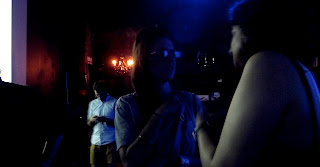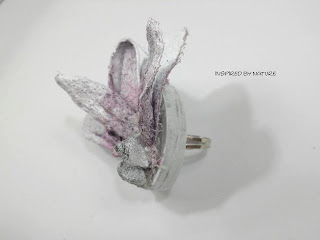 |
| Original photo, text, & layout by K.K.W On the cover, Valerie Kuehne, Felix Morelo & Glenn Cornett |
 |
| Photo courtesy of Lawrence De Martin. |
LM: Your very welcome Kerwin.
SP: Aside from an obvious love for music, what was it that pushed you to the tech side of it (speaker & sound design)?
LM: I come from a family of engineers and musicians and I am the nexus. My great grandfather was a metallurgist; my maternal grandfather designed the engine for the B-29, my paternal grandfather invented perfect binding. When I was nine my uncle Carl (also and aeronautical engineer) gave me a solar powered transistor radio kit for Christmas and I was hooked on tech. Funny thing is, I did not listen to music on that radio. We did not have a phonograph. Music came from the piano or singing. My father and mother played, one sister was a harp major the other sings. We got a turntable when I was 13 but it did not sound the same as music, as I had already been to a symphony in Boston and heard pipe organ weekly in church. I experimented some stereo, and designed and built recording studios including a mobile to capture live performance; but it still wasn't music coming out of the speakers, so I gave up for 20 years. Fast forward to 2004 when I joined the Connecticut Audio Society and we did a recording project with David Gilden of his band with Kora, Banjo, Fender bass and trap set. The premise was live two channel with members all bringing their minimalist recording setups, so the Kora had to be amplified. This opened my ears to the necessity of electro-acoustic amplification because of the foment in mixed orchestration.
SP: What makes your speaker design (the pair used at Spectrum) so formidable and separates them from others?
LM: My speakers are so good because my ears were not polluted by speakers or motors as a child. Acoustic musicians HEAR differently because of the daily exposure to the sound of fingers and lips making music, and I share the sensibilities. I have been to roughly 700 acoustic concerts in the last ten years to keep my hearing attuned to those sounds, listening MORE to acoustic music then to speakers. Also, I have a grand piano and three harpsicords at home.
SP: Are there any core elements you follow that give rise to quality speaker design, or you just play it by ear, depending on what your designing them for?
LM: My speakers are based on three disciplines:
A) Mimicry of the acoustics of natural instruments. Other speaker designers are making general purpose designs, which are a compromise. My first models are specifically for the violin family. They are increasing less suited to wind instruments, voice, plectrum instrumentsand least for percussion. I am working on wind and plectrum models. My system is not two channel because stereo as it is practiced is fake. The most critical part of the system is NO MIXING. Mixing is a spatial distortion. Rather, I rely on the OVOMOS principle: one voice, one mic, one speaker. Likewise, there is no splitting as in monitors. I have twelve speakers at Spectrum (four treble, three bass, five mid-bass). We also have two HiFi speakers and three PA type speakers, soon to be replaced with more of my experimental models.
A) Mimicry of the acoustics of natural instruments. Other speaker designers are making general purpose designs, which are a compromise. My first models are specifically for the violin family. They are increasing less suited to wind instruments, voice, plectrum instrumentsand least for percussion. I am working on wind and plectrum models. My system is not two channel because stereo as it is practiced is fake. The most critical part of the system is NO MIXING. Mixing is a spatial distortion. Rather, I rely on the OVOMOS principle: one voice, one mic, one speaker. Likewise, there is no splitting as in monitors. I have twelve speakers at Spectrum (four treble, three bass, five mid-bass). We also have two HiFi speakers and three PA type speakers, soon to be replaced with more of my experimental models.
 |
| Lawrence De Martin with his creation, at Spectrum. Original photo courtesy of De Martin, digital augmentation by K.K.W. |
C) SPACE. (The Final Frontier) This is ignored by all other speaker designers. Each natural instrument has a specific spatiality, or the way it fills a room so one size of speaker can't fit all instruments. Further, conventional speakers have warped timbre at an angle to the front, so the sound that bounces off the walls, floor and ceiling doesn't sound right. Since ALL speakers have this flaw people are acclimated to it. Audiophiles keep asking "if my system measures perfectly, how it does not sound real? I believe this is part of the answer- the speaker has to have flat frequency response at all angles.
The conventional "fix" is acoustic treatment making the room dead; or in more sophisticated manner making it diffuse; but this is even more artificial. My room is lively enough for acoustic chamber music and the speakers fit right in for some seamless mixed electro-acoustic ensembles.
This is also what Hall don't get right. Zankel Hall is a nearly perfect chamber hall, but acoustician Steve Haas specified variable acoustic treatments for performances amplified with conventional speakers. Most of the acoustic devices were cut from the budget, and the motorized curtain is typically not deployed. When they crank up the sound system the hall becomes unlistenable, even with earplugs!
SP: There's always aspects of what we do creatively that drives us, when it comes to sound & music what is it that drives you?
LM: I am driven by the search for truth, like Diogenes. I believe that the highest function of music is spirituality, tribality, and human to human direct communication. I was able to create a lifestyle where I hear the best acoustic musicians in the world in the best acoustic halls here in New York. I want to share that feeling with the rest of the world. The music business is about entertainment, convenience and artificial stimulation of adrenalin. This is bad for your health. Polygraph studies show that digitally compressed music (MP3, AAC) with exaggerated bass & beats but no dynamic range generates life shorting levels of stress. Music comes from silence, and synthetic noises like the sound of motors, metal, glass, and speaker distortion wear us out chemically.
SP: Given that human hearing does have limits, and sound technology keeps improving, do you think mans creation will exceed the limits of his God?
LM: Hearing is far better than most scientist believe. I had a conversation with Dr Edgar Choueiri, who is the chairman of plasma physics at Princeton. He took on a side project in spatial hearing, but admitted after it is as difficult as theoretical rocket science. I am optimistic that technology can eventually produce sounds that are healthy and healing as acoustic music, but not in our lifetime.
In summary, all speakers suck. My speakers suck less.
SP: Lawrence, having heard your speakers I'm must agree . You made so many great points about music, sound, and the tech side as well. Thanks for taking the time and imparting some of your knowledge on myself, and those who will read this. Cheers!
If you would like to know more, please send an email to Lawrence De Martin at acuvox@yahoo.com. "Art is the reason, art is the way."












































